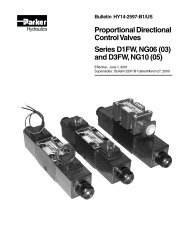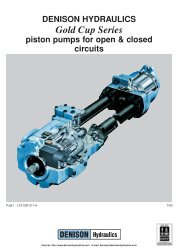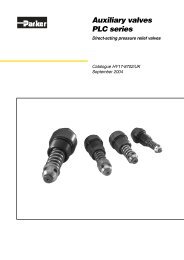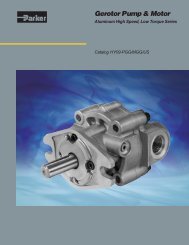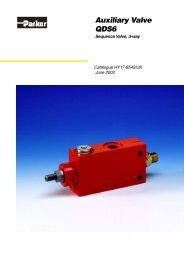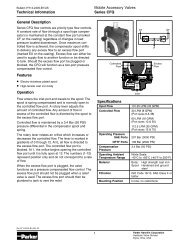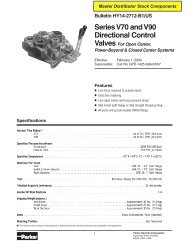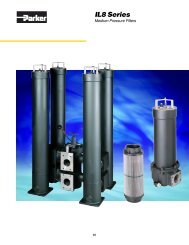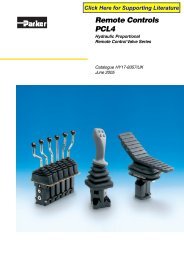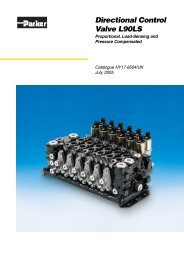Directional Control Valve P70 - Oleosistemas
Directional Control Valve P70 - Oleosistemas
Directional Control Valve P70 - Oleosistemas
Create successful ePaper yourself
Turn your PDF publications into a flip-book with our unique Google optimized e-Paper software.
Catalogue HY17-8546/UK<br />
System description<br />
<strong>Directional</strong> <strong>Control</strong> <strong>Valve</strong>s<br />
<strong>P70</strong><br />
B<br />
A<br />
PF<br />
PS<br />
P2B<br />
T4<br />
P1<br />
T1<br />
UL<br />
T2B<br />
T3B<br />
TP<br />
Principle circuit diagram for valve with open centre<br />
q(l/min)<br />
Flow rate in work port<br />
Open centre systems, OC<br />
(<strong>Valve</strong> with open centre, <strong>P70</strong>CF)<br />
The pump in a constant-flow system has fixed displacement,<br />
which means that the flow remains constant for a given engine<br />
speed. The pressure, however, changes to meet demand.<br />
Any oil that is not directed out to a consumer flows back to<br />
tank via the free-flow gallery (open centre) in the valve. When<br />
several lifting functions are activated simultaneously, the pressure<br />
is determined by the heaviest load. Simultaneously operated<br />
functions should therefore have roughly the same pressure<br />
needs, or be divided into separate pump circuits to minimise<br />
cross-functional interference and give good operating economy.<br />
Provided that most of the pump capacity is used, the OC system<br />
is very economical. For this reason, it is important for the system<br />
to have a pump of the right capacity.<br />
<strong>Control</strong> characteristics<br />
In hand-operated valves, there is no clear-cut relationship<br />
between the stroke of the lever and the speed of the load. The<br />
speed of the load will depend on the following four variables: its<br />
weight, the pump flow, the direction of force and the direction<br />
of movement of any other simultaneously operated loads. The<br />
reason for this is that, when more passages are opened subsequently,<br />
the flows redistribute themselves so that the pressure<br />
drop in all flow paths becomes equal.<br />
The <strong>P70</strong>CF’s customised valve spools give considerably<br />
better simultaneous-operating characteristics. In some cases, this<br />
can result in higher energy losses during the fine-metering stage.<br />
Our directional valves, which are designed to be remote<br />
controlled, are usually fitted with pressure compensated spools.<br />
This means that the regulated flow remains constant for a given<br />
lever stroke, regardless of any pressure variations within the<br />
system.<br />
80<br />
60<br />
40<br />
20<br />
0<br />
0<br />
250 bar lower<br />
150 bar<br />
50 bar<br />
50 bar lift<br />
150 bar<br />
250 bar<br />
20 40 60 80 100<br />
Lever stroke in %<br />
q pump<br />
In <strong>P70</strong>CF valves with hand-operated spools, speed is affected by<br />
the weight of the load, i.e. the heavier the lift load, the longer the<br />
lever stroke needed before the load starts to move. Conversely,<br />
the heavier the load to be lowered, the faster the lowering<br />
sequence.<br />
q(l/min)<br />
Flow rate in work port<br />
80<br />
60<br />
40<br />
250 bar lower<br />
50 bar<br />
q pump<br />
20<br />
50 bar lift<br />
250 bar<br />
0<br />
0 20 40 60 80 100<br />
Lever stroke in %<br />
In the <strong>P70</strong>CF equipped with FPC, PC, ECS and ECH closed<br />
spool-actuators, the spools are pressure compensated, with the<br />
result that the load’s influence on speed is negligible.<br />
<br />
Parker Hannifin<br />
Mobile <strong>Control</strong>s Division Europe<br />
Borås, Sweden



